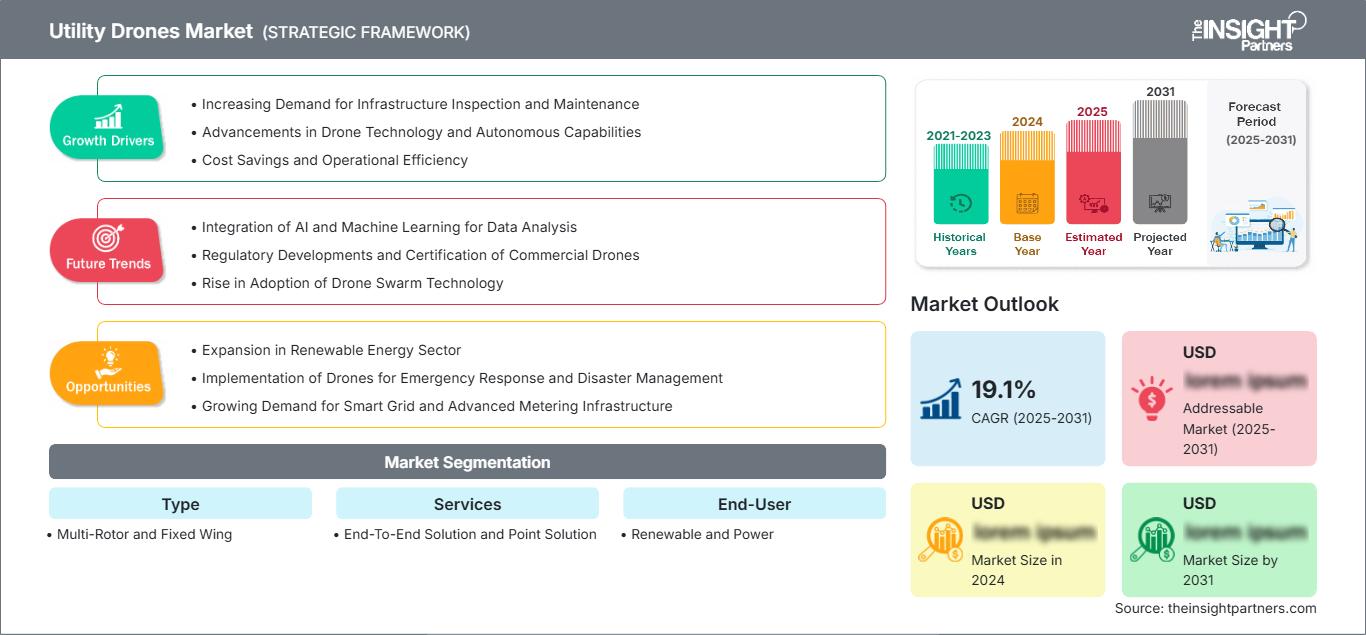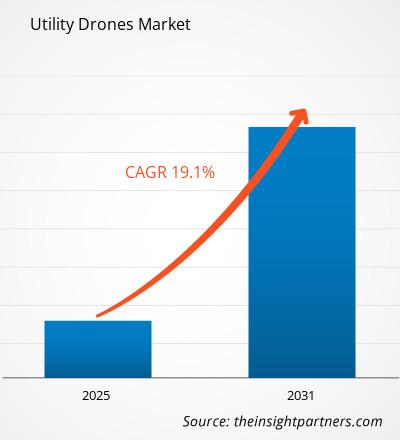The Utility Drones Market is expected to register a CAGR of 19.1% from 2025 to 2031, with a market size expanding from US$ XX million in 2024 to US$ XX Million by 2031.
The report is segmented by Type (Multi-Rotor and Fixed Wing), Services (End-To-End Solution and Point Solution), End-User (Renewable and Power). The global analysis is further broken-down at regional level and major countries. The report offers the value in USD for the above analysis and segments
Purpose of the Report
The report Utility Drones Market by The Insight Partners aims to describe the present landscape and future growth, top driving factors, challenges, and opportunities. This will provide insights to various business stakeholders, such as:
- Technology Providers/Manufacturers: To understand the evolving market dynamics and know the potential growth opportunities, enabling them to make informed strategic decisions.
- Investors: To conduct a comprehensive trend analysis regarding the market growth rate, market financial projections, and opportunities that exist across the value chain.
- Regulatory bodies: To regulate policies and police activities in the market with the aim of minimizing abuse, preserving investor trust and confidence, and upholding the integrity and stability of the market.
Utility Drones Market Segmentation
Type
- Multi-Rotor and Fixed Wing
Services
- End-To-End Solution and Point Solution
End-User
- Renewable and Power
Geography
- North America
- Europe
- Asia-Pacific
- South and Central America
- Middle East and Africa
You will get customization on any report - free of charge - including parts of this report, or country-level analysis, Excel Data pack, as well as avail great offers and discounts for start-ups & universities
Utility Drones Market: Strategic Insights

-
Get Top Key Market Trends of this report.This FREE sample will include data analysis, ranging from market trends to estimates and forecasts.
Utility Drones Market Growth Drivers
- Increasing Demand for Infrastructure Inspection and Maintenance: Utility drones are becoming essential tools for inspecting and maintaining infrastructure such as power lines, oil and gas pipelines, and wind turbines. These drones allow for faster, safer, and more cost-effective inspections, reducing the need for human workers to perform high-risk tasks in hazardous environments. The growing need for infrastructure monitoring and maintenance, combined with the rising demand for safety and operational efficiency, is a major driver for the utility drones market.
- Advancements in Drone Technology and Autonomous Capabilities: The rapid advancements in drone technology, including improved sensors, longer battery life, and enhanced autonomous capabilities, are fueling the growth of the utility drones market. These technological improvements allow drones to cover larger areas, perform complex tasks with greater precision, and operate with minimal human intervention. The ability to conduct automated inspections and gather real-time data is making drones a more attractive and viable solution for utility companies, driving market demand.
- Cost Savings and Operational Efficiency: Utility drones help companies reduce operational costs by minimizing the need for expensive and time-consuming manual inspections, often involving climbing, scaffolding, or helicopters. Drones can also collect large amounts of data in a fraction of the time it would take with traditional methods, improving operational efficiency. With utilities seeking ways to optimize costs while maintaining high safety standards, the economic benefits provided by drones are a significant driver of market growth
Utility Drones Market Future Trends
- Integration of AI and Machine Learning for Data Analysis: One of the key trends in the utility drones market is the increasing integration of artificial intelligence (AI) and machine learning algorithms for real-time data processing and analysis. Drones are equipped with sensors that collect large volumes of data, such as thermal, infrared, and high-resolution visual images. AI and machine learning help automate the analysis of this data, enabling utility companies to detect potential issues like equipment malfunctions or energy inefficiencies more accurately and efficiently, reducing the need for manual intervention.
- Regulatory Developments and Certification of Commercial Drones: The regulatory landscape for drone usage is evolving as governments and aviation authorities develop more structured guidelines for commercial drone operations. In regions such as North America and Europe, the development of rules for beyond-visual-line-of-sight (BVLOS) operations, drone certifications, and airspace management is driving market growth. As regulations become clearer and more streamlined, utility companies can deploy drones on a larger scale, accelerating the adoption of drones for infrastructure inspection and maintenance tasks.
- Rise in Adoption of Drone Swarm Technology: The use of drone swarm technology is gaining traction in the utility drones market. By deploying multiple drones that communicate and operate in unison, utility companies can cover larger areas more efficiently, perform simultaneous inspections, and gather comprehensive data in less time. This trend is particularly useful for large-scale infrastructure projects, such as power grid networks, where the efficiency and speed of operations are crucial for minimizing downtime and improving service reliability
Utility Drones Market Opportunities
- Expansion in Renewable Energy Sector: The growth of the renewable energy sector presents significant opportunities for utility drones, especially for inspecting and maintaining wind turbines, solar farms, and other renewable energy infrastructures. Drones equipped with specialized sensors and imaging tools can efficiently assess the condition of these facilities, perform preventive maintenance, and identify issues like mechanical wear, reducing downtime and increasing energy production efficiency. As the renewable energy industry expands, the demand for drones tailored to its specific needs is expected to rise.
- Implementation of Drones for Emergency Response and Disaster Management: Utility drones are increasingly being deployed for emergency response and disaster management, providing critical real-time data in the aftermath of natural disasters, such as hurricanes, wildfires, and earthquakes. Drones can access hard-to-reach areas, assess damage to infrastructure, and provide live video feeds, enabling faster decision-making and recovery efforts. This growing role of drones in emergency management creates significant opportunities for the utility drones market to expand its reach and diversify its applications.
- Growing Demand for Smart Grid and Advanced Metering Infrastructure: The integration of smart grids and advanced metering infrastructure (AMI) in the utility sector is opening up new opportunities for utility drones. Drones can be utilized to inspect and monitor the physical assets of smart grids, including substations, transmission lines, and smart meters, enabling utilities to manage their networks more effectively. As utilities adopt more advanced and interconnected grid systems, drones equipped with monitoring and diagnostic capabilities will play a crucial role in ensuring system reliability and performance
Utility Drones Market Regional Insights
The regional trends and factors influencing the Utility Drones Market throughout the forecast period have been thoroughly explained by the analysts at The Insight Partners. This section also discusses Utility Drones Market segments and geography across North America, Europe, Asia Pacific, Middle East and Africa, and South and Central America.
Utility Drones Market Report Scope
| Report Attribute | Details |
|---|---|
| Market size in 2024 | US$ XX million |
| Market Size by 2031 | US$ XX Million |
| Global CAGR (2025 - 2031) | 19.1% |
| Historical Data | 2021-2023 |
| Forecast period | 2025-2031 |
| Segments Covered |
By Type
|
| Regions and Countries Covered |
North America
|
| Market leaders and key company profiles |
|
Utility Drones Market Players Density: Understanding Its Impact on Business Dynamics
The Utility Drones Market is growing rapidly, driven by increasing end-user demand due to factors such as evolving consumer preferences, technological advancements, and greater awareness of the product's benefits. As demand rises, businesses are expanding their offerings, innovating to meet consumer needs, and capitalizing on emerging trends, which further fuels market growth.

- Get the Utility Drones Market top key players overview
Key Selling Points
- Comprehensive Coverage: The report comprehensively covers the analysis of products, services, types, and end users of the Utility Drones Market, providing a holistic landscape.
- Expert Analysis: The report is compiled based on the in-depth understanding of industry experts and analysts.
- Up-to-date Information: The report assures business relevance due to its coverage of recent information and data trends.
- Customization Options: This report can be customized to cater to specific client requirements and suit the business strategies aptly.
The research report on the Utility Drones Market can, therefore, help spearhead the trail of decoding and understanding the industry scenario and growth prospects. Although there can be a few valid concerns, the overall benefits of this report tend to outweigh the disadvantages.
Frequently Asked Questions
What are the options available for the customization of this report?
What are the future trends of the utility drones market?
What are the deliverable formats of the market report?
What are the driving factors impacting the global utility drones market?
What is the expected CAGR of the utility drones market
- Historical Analysis (2 Years), Base Year, Forecast (7 Years) with CAGR
- PEST and SWOT Analysis
- Market Size Value / Volume - Global, Regional, Country
- Industry and Competitive Landscape
- Excel Dataset
Recent Reports
Testimonials
Reason to Buy
- Informed Decision-Making
- Understanding Market Dynamics
- Competitive Analysis
- Identifying Emerging Markets
- Customer Insights
- Market Forecasts
- Risk Mitigation
- Boosting Operational Efficiency
- Strategic Planning
- Investment Justification
- Tracking Industry Innovations
- Aligning with Regulatory Trends





















 Get Free Sample For
Get Free Sample For